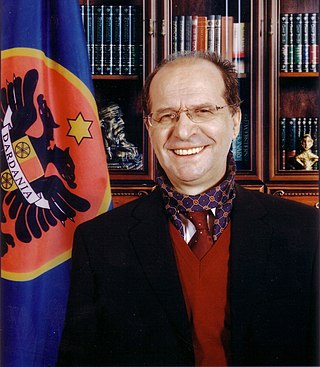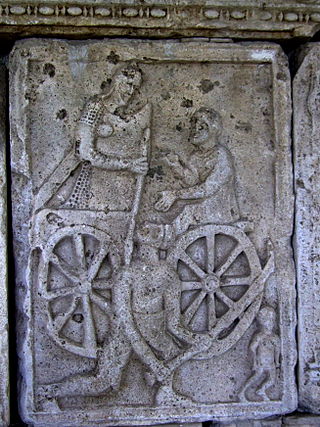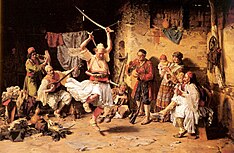
Circle dance, or chain dance, is a style of social dance done in a circle, semicircle or a curved line to musical accompaniment, such as rhythm instruments and singing, and is a type of dance where anyone can join in without the need of partners. Unlike line dancing, circle dancers are in physical contact with each other; the connection is made by hand-to-hand, finger-to-finger or hands-on-shoulders, where they follow the leader around the dance floor. Ranging from gentle to energetic, the dance can be an uplifting group experience or part of a meditation.

Weapon dances incorporating swords or similar weapons are recorded throughout world history. There are various traditions of solo and mock-battle (Pyrrhic) sword dances in Africa, Asia and Europe. Some traditions use sticks or clubs in place of bladed weapons, while most modern performers employ dulled replications to avoid injury.

Ibrahim Rugova was a Kosovo-Albanian politician, scholar, and writer, who served as the President of the partially recognised Republic of Kosova, serving from 1992 to 2000 and as President of Kosovo from 2002 until his death in 2006. He oversaw a popular struggle for independence, advocating a peaceful resistance to Yugoslav rule and lobbying for U.S. and European support, especially during the Kosovo War.
Music of Kosovo is music that originates from Kosovo, a country in the Balkans. Kosovo's population is mainly Kosovo Albanians, also known as Kosovars, and there are various minority ethnic groups as well. Kosovan music is closely related to that of neighbouring Albania, as well as to that of countries in the former Yugoslavia.

The People's Movement of Kosovo was a political party in Kosovo active after the Kosovo War, having originally been founded as a political movement of Albanian nationalists in 1982. Despite participating in several elections in autonomous Kosovo, its pre-war existence was its most historically significant period. Historically, its support and membership came from Albanian diaspora, especially within Switzerland and Germany, originating mainly from former Yugoslav republics.

The rhomphaia was a close-combat bladed weapon used by the Thracians as early as 350-400 BC. Rhomphaias were weapons with a straight or slightly curved single-edged blade. Although the rhomphaia was similar to the falx, most archaeological evidence suggests that rhomphaias were forged with straight or slightly curved blades, presumably to enable their use as both a thrusting and slashing weapon. The blade was constructed of iron and used a triangular cross section to accommodate the single cutting edge with a tang of rectangular cross section. Length varied, but a typical rhomphaia would have a blade of approximately 60–80 cm (24–31 in) and a tang of approximately 50 cm (20 in). From the length of the tang, it can be presumed that, when attached to the hilt, this portion of the weapon would be of similar length to the blade.

In European folklore, a need-fire is a fire kindled by friction, which is lit in a ritual and used as protective magic against murrain, plague and witchcraft. It was a tradition in parts of Europe, practiced by Germanic, Gaelic and Slavic peoples until the 19th century, and by Albanians until the 20th century.

Worship or deification of fire, or fire rituals, religious rituals centred on a fire, are known from various religions. Fire has been an important part of human culture since the Lower Paleolithic. Religious or animist notions connected to fire are assumed to reach back to such early prehuman times.

The winter solstice, also called the hibernal solstice, occurs when either of Earth's poles reaches its maximum tilt away from the Sun. This happens twice yearly, once in each hemisphere. For that hemisphere, the winter solstice is the day with the shortest period of daylight and longest night of the year, and when the Sun is at its lowest daily maximum elevation in the sky. Each polar region experiences continuous darkness or twilight around its winter solstice. The opposite event is the summer solstice.

Albanian paganism comprises the pagan customs, beliefs, rituals, myths and legends of the Albanian people. The elements of Albanian mythology are of ancient Paleo-Balkanic origin and almost all of them are pagan. Ancient paganism persisted among Albanians, and especially within the inaccessible and deep interior – where Albanian folklore evolved over the centuries in a relatively isolated tribal culture and society – it has continued to persist, or at most it was partially transformed by the Christian, Muslim and Marxist beliefs that were either to be introduced by choice or imposed by force. The Albanian traditional customary law (Kanun) has held a sacred – although secular – longstanding, unwavering and unchallenged authority with a cross-religious effectiveness over the Albanians, which is attributed to an earlier pagan code common to all the Albanian tribes. Indeed, the Kanun contains several customary concepts that clearly have their origins in pagan beliefs, including in particular the ancestor worship, animism and totemism, which have been preserved since pre-Christian times. Albanian traditions have been orally transmitted – through memory systems that have survived intact into modern times – down the generations and are still very much alive in the mountainous regions of Albania, Kosovo and western North Macedonia, as well as among the Arbëreshë in Italy and the Arvanites in Greece, and the Arbanasi in Croatia.

Ernest Koliqi was an Albanian journalist, pro-Axis politician, translator, teacher and writer.
The drangùe is a semi-human winged divine hero in Albanian pagan mythology, associated with weather and storms. He is the archetype of light and good, the complementary and opposing force to kulshedra, the archetype of darkness and evil. Babies destined to become drangue are born with their heads covered in caul and with two or sometimes four wings under their arms. The drangue hold supernatural powers, especially in the wings and arms. A drangùe is made invulnerable by the singular conjunction produced at his birth, and can die only if this conjunction is repeated once again.

Enji is the old name of the fire god in the Albanian pagan mythology evidently contained in the week day name that was dedicated to him – e enjte – the Albanian word for Thursday. The Fire – Zjarri – is deified in Albanian tradition as releaser of light and heat with the power to ward off darkness and evil, affect cosmic phenomena and give strength to the Sun, and as sustainer of the continuity between life and afterlife and between the generations. The divine power of Fire is used for the hearth and the rituals, including calendar fires, sacrificial offerings, divination, purification, and protection from big storms and other potentially harmful events. Fire worship and rituals are associated with the cult of the Sun (Dielli), the cult of the hearth (vatër) and the ancestor, and the cult of fertility in agriculture and animal husbandry. Fire rituals that are commonly found among Indo-European peoples, including the Albanians, have been firstly attested by the Vedas, with hymns dedicated to the fire god Agni. Described in written sources since 1482, the Albanian fire rituals have been historically fought by the Christian clergy, without success. The cult of the mystic fire and the fire ritual practices have played a prominent role in the lives of all the Albanian people until the 20th century, and in rural areas they continue to be important for Albanian traditional customs even in the present days.

Rugova is a mountain region located to the north-west of the city of Peja, in Kosovo. According to notes of Rugova it has been inhabited since before the 12th century. In 2013, it was designated a national park by the Parliament of Kosovo.

Skanderbeg Square is a square in Pristina, Kosovo.

Zojz is a sky and lightning god in Albanian pagan mythology. Regarded as the chief god and the highest of all gods, traces of his worship survived in northern Albania until the early 20th century, and in some forms still continue today. The old beliefs in the Sky are pagan beliefs preserved by Albanians since ancient times. In Albanian the god who rules the sky is referred to as i Bukuri i Qiellit, a phrase that is used in pagan contexts for the Sun (Dielli), worshiped as the god of light, sky and weather, giver of life, health and energy, and all-seeing eye. The sacred significance of one of the main symbols of the sky cult – the eagle – has been scrupulously preserved by Albanians, who have always considered it their animal totem. An epithet considered to be associated with the sky-god is "father", thought to be contained in the Albanian noun Zot, used to refer to the supreme entity. A remarkable reflection of Proto-Indo-European mythology associated with the dawn goddess *H₂éwsōs is the Albanian tradition according to which the dawn goddess – Prende – is the daughter of the sky god – Zojz.

The vatër is the domestic hearth in Albanian culture. The fire of the domestic hearth holds divine attributes in Albanian beliefs, being considered the sustainer of the continuity between the world of the living and that of the dead, and ensuring the continuity of the tribe from generation to generation. The absence of fire in a house is traditionally considered a great curse. In Albanian folk beliefs the fire hearth is the symbol of fire as the offspring of the Sun (Dielli). In Albanian tradition the deified fire (zjarri) was evidently also called with the theonym Enji, the god to whom Thursday – e enjte – was dedicated in the Albanian language.

Kadri Bajri (1823-1913) was an Albanian commander of the Albanian League of Prizren from Rugova.
Astrit Haraqija, whose last name is sometimes spelled as Haraqia, is a politician in Kosovo. He was the minister of culture, youth, and sports in the Kosovo government from 2004 to 2008, serving as a member of the Democratic League of Kosovo (LDK).

Dielli, the Sun, holds the primary role in Albanian pagan customs, beliefs, rituals, myths, and legends. Albanian major traditional festivities and calendar rites are based on the Sun, worshiped as the god of light, sky and weather, giver of life, health and energy, and all-seeing eye. In Albanian tradition the fire – zjarri, evidently also called with the theonym Enji – worship and rituals are particularly related to the cult of the Sun. Ritual calendar fires or bonfires are traditionally kindled before sunrise in order to give strength to the Sun and to ward off evil. Many rituals are practiced before and during sunrise, honoring this moment of the day as it is believed to give energy and health to the body. As the wide set of cultic traditions dedicated to him indicates, the Albanian Sun-god appears to be an expression of the Proto-Indo-European Sky-god.




















